The GroupC chassis
After a serious cleaning and a complete inventory, some parts are missing (especially the differential), the motor pinion, the original spur gear was replaced by a totally worn F103 63T, the differential joint is from an F103 (too long) and several screws need replacement. I had the part list to place an order at my favorite provider and a few days later, everything was there for a complete rebuilt.
The GroupC chassis offers a ground clearance setup thanks to spacers at the front and rear of the chassis: I chose the highest position in order to preserve the chassis from any pebble that may become dangerous for the chassis plate with the low clearance setup. GroupC chassis are pretty quick and fast (close to the F102 chassis). The slightest default on the track can lead to severe consequences: I preferred to be conservative.
The rear of the chassis
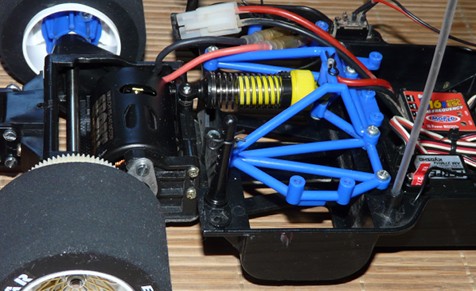
The front end

Building this chassis reminds of a puzzle as I showed it in my article on the on-road chassis: the central bathtub links to the front drivetrain thanks to a lower FRP part and a blue plastic part on the top side. This allows 3 different chassis wheelbase: 280mm (Mercedes C11, Jaguar XJR-12, Nissan R91 CP), 270mm (Mazda 787B) and 260mm (Nissan 300ZX IMSA GTO, Ferrari F40). At the rear, the drivetrain is pretty much identical to the F102's, the differential setup being only moved from the left to the right wheel.
The assembly is pretty easy and straight away: you only need to carefully follow the instructions when assembling the differential. The good part is there's plenty of room to install electronics and cable-tie everything: this is quite a difference compared to the F102 chassis of my Footwork FA13.
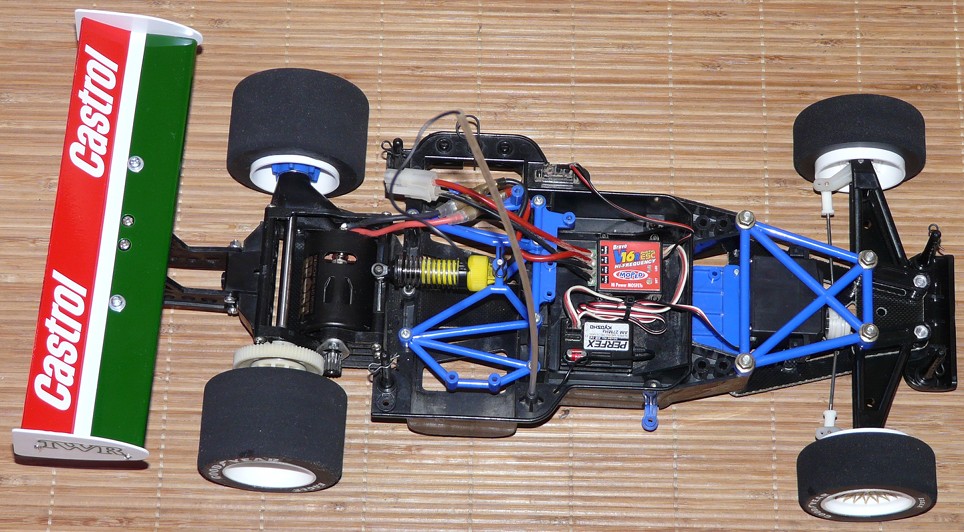
As for the motor, I went for a brand new Sport Tuned with a 14T pinion to stays as per original instructions even if my friend Teamneogordini experienced it to be a little bit to long for the track where my Jaguar (but he drives a Mercedes C11 and everyone knows a Jaguar is much faster than a Mercedes ![]() ).
).
The Jaguar XJR-12 bodyshell
Since the chassis belongs to the Jaguar XJR-12, I decided to go for the body it was meant for. Thanks Tamiya for re-releasing it in Finished Body version because it is easy to find and for a reasonable price: exact references are 9400307 for the body and 9400308 for the rear wing. For those who really want to practice their skills on this bodyshell, references are 9805382 (with wing) and 9495116 for the stickers. Bad news: the cockpit set that was already an option back in 1991 was not re-released and it is now very rare and expensive.
Finished Body bodyshell

Direct fit onto the chassis

I only added a personal touch by painting the rims in gold. The Good Year stickers on the tires (reference 9495472) were part of the original decoration.
For a better look, I used a technique my friend Kyosuke explained me :
- entirely paint the rims in flat black
- paint the honeycomb and the rim side in silver
- then paint the honeycomb in gold
Here's the result :
Only the honeycomb is painted in gold

Following Kyosuke's technique
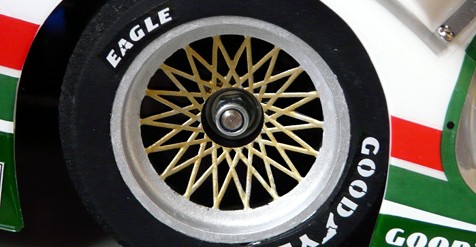
The flat black background will reinforce the visual contrast of the silver and gold paints. Painting the honeycomb in silver before painting them gold is a solution to avoid the black background darkens the color. In fact, the silver paint better covers than the gold paint: painting a coat of silver will make the gold look more shiny.
Update:
After the first test run and fears about the bodyshell, I felt additional protections were required at the front. Typically, these are those matters you spend hours working on them but always hope that you'll never know if they are efficient or not ![]() .
.
The problem is this: the bumper is very short because it is only meant to protect the chassis. The front of the bodyshell is very low profile and at about 6,5cm further than the bumper.
Remember the metal bumper that came with my model? Remind it scrolling to the top if needed. It is quite longer than the stock bumper, but this was custom made by the previous owner. I can't use it as is since it is too high at its front and prevents the body to take place.
This is when my friend Dremel steps in to remove the annoying part: half a disk later (did I mentioned the steel is pretty thick?), the bumper can be fixed and the body now fits. Much better but still too short: the body nose is still 4cm away. Since I reached the limit on bumper side and since I don't like the idea of hard metal protecting weak lexan, it's time to dig up a foam bumper I had left from my TB-01 chassis (reference 53353 TG10 Urethane Bumper). Since I can't fix it onto the metal bumper because there's no room left, I fixed it onto the bodyshell with double-sided tape. While working on this part of the body, I also placed a few bands of reinforced tape on the inner body nose since it can't hurt.
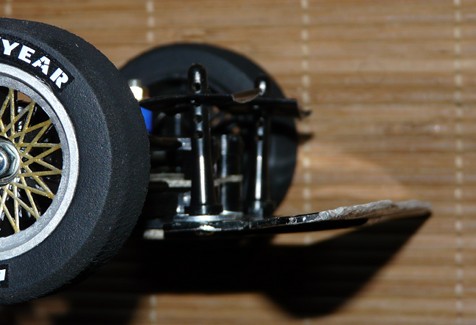
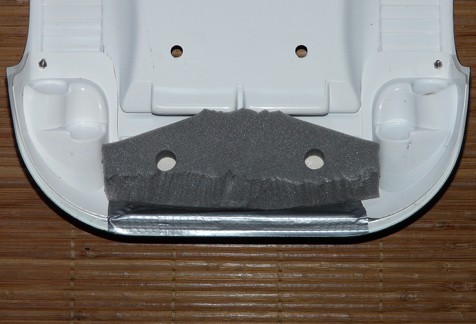
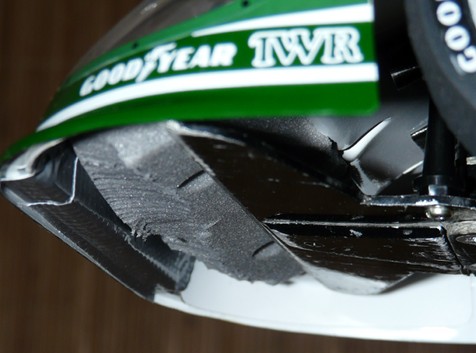
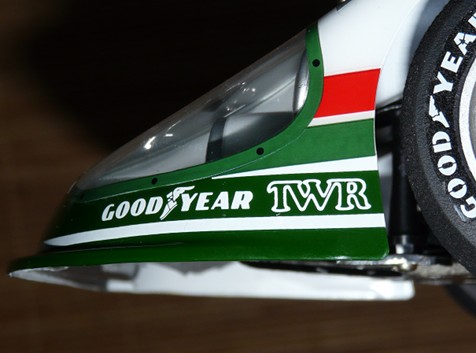
The foam bumper needs to be cut to fit in between the two inner light buckets and to cut a beveled angle at its front so that it can't be seen from outside: this way, the foam is virtually invisible and I hope it offers good protection.
First run
I did a first test session to check everything on my model before I prepare an upcoming session with friends. The goal was also to discover this model and its performance, but also to get help and advices from my friend Teamneogordini who brought his Mercedes C11.
As expected, the chassis handles pretty much like my F102 Footwork FA13, but there are some important differences. The chassis is more steady than the F102 (in straight lines and corners) thanks to a longer wheelbase and wider track, but it is also much heavier. The Sport Tuned motor is more than welcome to provide performance that can compare to the standard 540 powered F102. Despite of this, the GroupC chassis generally behaves softer than my Formula 1 and thus it is easier to control since it forgives more driver mistakes.
On the other side, any driving fault is an immediate bill for the bodyshell: being very low on the track, any incursion in the grass turns the Jaguar into a lawn mover. The front of the chassis doesn't feature any protection for the bodyshell so I'll either have to stay on the track or find a solution to preserve the bodyshell.
PS: the Mercedes C11 was faster than my Jaguar. Might be due to the driver ![]() .
.
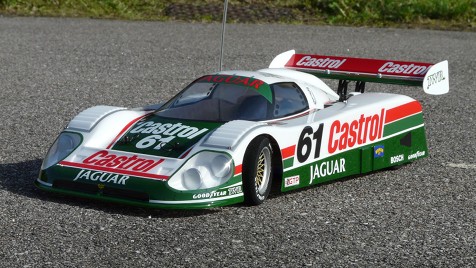
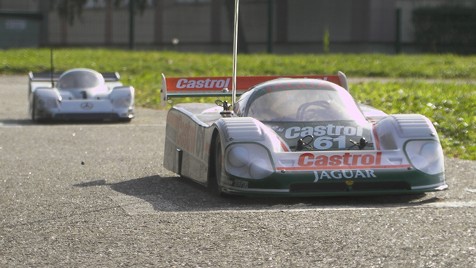
Related articles




